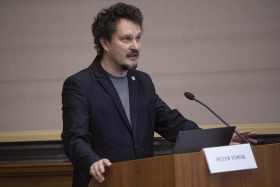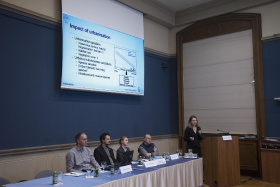News
Key Issues in Urban Greening
Video of the special session held at MTA HQ
 Photo by MTA Kommunikáció/Tamás Szigeti
Photo by MTA Kommunikáció/Tamás SzigetiWhat’s the benefit for us urban dwellers of encountering wildflower meadows or vegetable gardens on our way home? Does sex reversal in a significant number of urban frogs help in adaptation? Are urban birds any smarter than those living in their natural habitats? These were some of the questions discussed at the special session organized by the Academia Europaea Budapest Knowledge Hub on 22 March 2023, which focused on the conservation and restoration of urban habitats.
Only 3% of the surface area of the Earth is urbanised, yet more than half of the Earth’s human population live in towns or cities. The impacts of the complex process of urbanisation are the most serious sustainability challenge of the 21st century, from an environmental, economic and social perspective. It is no coincidence that urbanisation as a phenomenon is often labelled as something negative, even though, as Péter Török, Co-Chair of the special session and Co-chair for the Urban Sustainability thematic mission of the AE Budapest Hub, pointed out in his welcome address at the start of the session, urbanisation does offer a number of opportunities in terms of sustainability when it comes to the creation of smart cities, green spaces, or the conservation of natural or semi-natural habitats and the provision of environmental education.
Preserving and restoring urban green habitats is just as essential as understanding the impacts of urbanisation on these natural communities, added Péter Batáry, the other Co-Chair of the session. This is exactly the aim of the experts who presented their latest research results on this topic at the special session held in the Small Lecture Hall of the Palace of the Hungarian Academy of Sciences.
Green areas in the city
Monika Egerer (Technical University of Munich, Germany) presented her study of community gardens in the urban landscapes of Munich and Berlin. As she explained, the two opposing concepts of sustainable agricultural production, land sparing and land sharing, continue to be debated also in the urban context. While land sparing favours the creation of large green spaces, like separated islands, next to the dense city centres, land sharing, on the contrary, favours the creation of smaller green surfaces integrated across the urban landscape in a mosaic of connected habitat patches. The research results demonstrate that well-designed - i.e., along the principles of land sharing - urban gardens supporting a variety of functions, contribute to an adequate level of connectivity among green patches, leading to climate change mitigation and an increase in biodiversity.
A similar conclusion was drawn by Christina Fischer (Anhalt University of Applied Sciences, Bernburg, Germany), who explained how wildflower patches along motorways contribute to an increase in biodiversity and pollinator abundance. Further studies will be needed to determine whether such habitat changes may involve any risk of ecological traps being created.
In urban habitats, depending on the level of disturbance, there is a great degree of variation in the quality of green areas, to which the communities living there adapt in various ways. Taking leaf size and leaf dry-matter content as indicators, Carlo Ricotta, from the Sapienza University of Rome (Italy), studied the adaptation strategies of urban plants and reported on the results in his presentation.
 Photo by MTA Kommunikáció/Tamás Szigeti
Photo by MTA Kommunikáció/Tamás SzigetiPollinators close to human communities
The role of pollinators is truly invaluable for both ecology and economy. Several presentations have addressed the issues of what kind of impact human activities have on the pollinator communities of urban environments and in what ways the abundance and diversity of pollinators can be increased in urban habitats. It is a general trend for urban environments to have more homogeneous pollinator communities, yet urban habitats rich in flowering plants often accommodate large and species-rich pollinator communities. This is why the creation and preservation of pollinator-friendly urban habitats is crucial for long-term conservation.
The functional traits of bees (body size, food specialization, reproduction and active period) determine their ability to adapt to human disturbance in their actual habitats. Analysing these traits, Weronika Banaszak-Cibicka, from Poznań University (Poland), found that urban bee communities are predominantly made up of common, cosmopolitan and eusocial species with a long active period. Solitary species (potentially brood parasites) with a shorter active period are more sensitive to human disturbance and tend to occur in smaller numbers in urban habitats. More details about the results of this research can be found in the presentation.
Federico Morelli, from the Czech University of Life Sciences Prague (Czechia), highlighted, among other things, the importance of the careful planning of urban green areas for birds in terms of taxonomy, functionality and phylogenetics. One of Morelli’s findings was that weak phylogenetic relatedness among birds (i.e., being distant relatives to one another) significantly reduces competition and biotic homogenisation (the latter may be thought of as the equivalent to the sphere of flora and fauna of globalisation in human societies), while enabling a larger variety of ecological functions.
Csilla Stenger-Kovács (University of Pannonia, Veszprém, Hungary), described in her presentation the complex effects of agricultural land use and urbanisation on aquatic ecosystems. She studies diatoms: organisms considered major indicator species for the ecological quality of waters. Rather than taking the traditional approach of concentrating on species diversity, Stenger-Kovács opted to examine diatom communities in aquatic ecosystems on a functional basis. Her presentation gave a summary of her findings.
Amphibians and urbanisation
A fresh perspective was taken by Veronika Bókony, from the Centre for Agricultural Research at the Eötvös Loránd Research Network, Budapest (Hungary), who primarily studies populations of species rather than multispecies communities. It has emerged that urbanisation effects (such as air pollution, light pollution, noise pollution, water pollution, Urban Heat Island effect and human disturbance) are not limited to communities. Urban individuals differ both in their behaviour and traits from non-urban conspecifics. These differences may or may not be adaptive. Bókony studied the functional traits of the common toad and those of the agile frog to show how amphibians cope with urbanisation. She found that the individuals studied exhibited a high level of phenotypic plasticity, indicated by, among other things, increased toxin production and the specificities in hormonal stress response to changes in the environment. This phenotypic plasticity, however, comes with a price. Female toads captured from urban habitats produced a thicker jelly coat around their eggs than conspecifics living in the wild, presumably to protect their eggs from predators and pollutants. Yet, offspring protected this way were found to take longer to develop and to have a smaller body mass. Research has also demonstrated that early-life stressors (such as heat waves or pollution) may disrupt tadpole development and lead to a change in the phenotypic sex of the adult animal. In case of agile frogs living in urban habitats, one-fifth of the individuals observed showed sex reversal. Whether this phenomenon may be adaptive or not was also discussed at the end of the presentation.
Péter Batáry, from the Centre for Ecological Research, Vácrátót (Hungary), Co-Chair of the conference, presented a set of meta-analyses he and his colleagues had made of primary studies related to the topics covered in this special session, showing in particular how bird communities change along an urbanisation gradient.
Béla Tóthmérész, from University of Debrecen (Hungary), defined the homogenisation hypothesis and tested it through an analysis of ground beetles (carabids). In contrast to most urbanization studies, he concluded from his results that urban habitats can also be characterised by increased species richness, and a great number of species have been found in his study to live exclusively in urban environments, completely missing from suburban and rural habitats. However, an overwhelming majority of the species found were generalists, that is, species tolerating a wide range of environmental conditions. The presentation led us through the consecutive steps of this research work.
Adaptation of birds
One might think urbanisation has a positive effect on the cognitive abilities of birds. From time to time videos go viral on the internet showing birds rummaging in trash cans, opening up abandoned food cans or picking up cigarette butts.
But do urban birds really differ in their cognitive abilities from birds living in natural habitats? Testing the problem-solving skills of avian species, Ernő Vincze, from Lund University (Sweden), showed that on the whole this is not the case, even though in certain situations better cognitive abilities may contribute to a better adaptation to urban environments.
To watch the presentations of Section 1 of the conference, click here.
To watch the presentations of Section 2 of the conference, click here.


